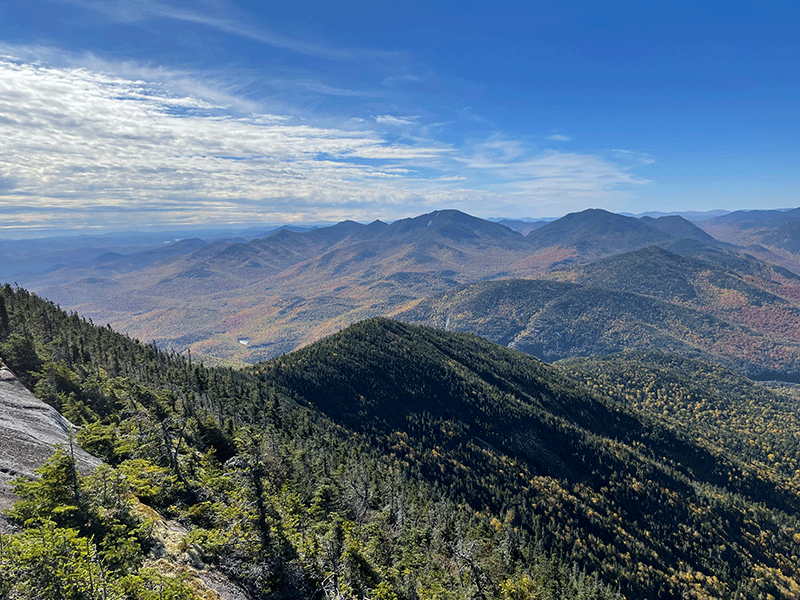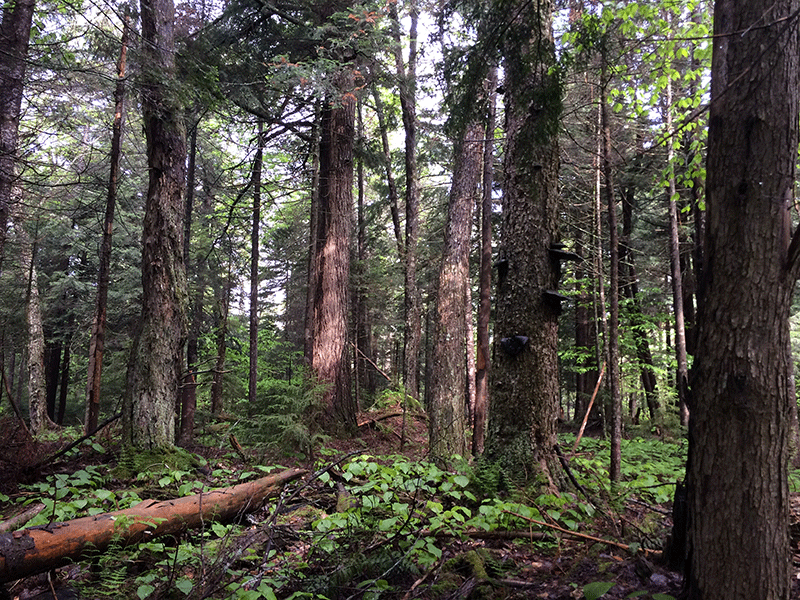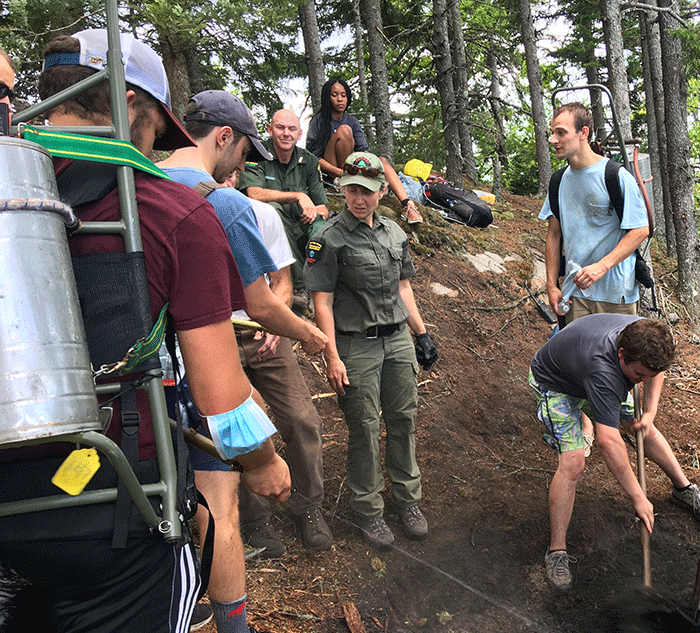A number of organizations (listed at the end) coalesced around a set of priorities for the Adirondack Park in the 2023-24 New York State budget. This coalition believes that the Adirondack Park faces unprecedented challenges stemming from climate change, soaring recreational pressures on its trails and waterways, an outdated, 50-year old Adirondack Park Agency Act that has not kept up with scientific trends and mounting development pressures, and a need to diversify the people it serves. We need new and courageous leadership from the Governor and state agencies to ensure that Adirondack Park is well-protected now and preserved for future generations.
As Governor Kathy Hochul puts together her Executive Budget proposal for the 2023-24 fiscal year, we urged her to disprove the false choice between the Adirondack Park’s environment and economy. We’ve always believed that a healthy environment and healthy economy are not mutually exclusive, but go hand-in-hand. Bold, strategic investments in the preservation of the Adirondack Park are essential to the regional economy and vitality of our small rural communities. The Governor’s new state budget will show priorities for the Adirondack Park and we urge you to make the following key investments as core parts of your Adirondack Park agenda:
- $400,000 for the Adirondack Diversity Initiative, $2.1 million for the Timbuctoo Summer Climate and Careers Institute and $3 million for the Adirondack Experience (ADKX) exhibit on the African American Experience in the Adirondacks.
- $400 million for the Environmental Protection Fund, including expanded funding for Forest Preserve Stewardship, Land Protection, Invasive Species Control, studying New York’s coyote and wolf populations, and funding environmental research in New York.
- Making new, key investments in Forest Preserve trail development.
- Funding reform and rehabilitation of the Adirondack Park Agency so that it fulfills its statutory responsibility to be the lead agency for planning in the Adirondack.
- Making new investments to support affordable housing programs in Adirondack communities by funding an Adirondack Park Affordable Housing Task Force.
- Committing to doubling and diversifying the Forest Rangers by funding a new Ranger Academy andexpanding Ranger.
- Funding the critical, 3-year, $6 million research program “Survey of Climate Change and Adirondack Lakes Ecosystems.”
- Allocating $1 billion for the Water Infrastructure Improvement Act to help municipalities across New York.
Click here to read the full letter to Governor Hochul.
Fostering Diversity, Equity, Inclusion, and Climate Justice for the Adirondacks
We all must do more to ensure that all New Yorkers have the opportunity to enjoy and benefit from the precious resources of the Adirondack Park. The Adirondacks can be a place of respite, a critical resource in fightingclimate change, and a place of opportunity for those pursuing green jobs.
The fight for climate and social justice demands that as we fight climate change, we better connect the AdirondackPark with communities disproportionately impacted by it. We celebrate that New York’s Adirondack Park was a cradle of the early fight for Black suffrage. In that same spirit of opportunity, the Timbuctoo Summer Climate Careers Institute will expose high school students to green job opportunities and foster the next generation of climate advocates. The curriculum is developed and the first year of this program is set to be implemented in summer 2023. Please fund the Timbuctoo Summer Climate and Careers Institute at $2.1 million once again this year.
The Adirondack Diversity Initiative (ADI) works to make the Adirondack region more welcoming and inclusive. ADI currently benefits from a $300,000 sub-allocation in the Environmental Protection Fund. Along with many other ongoing efforts, ADI provides critical anti-bias training to Environmental Conservation Officers, and that work continues to grow. We support the Adirondack North Country Association’s proposal to increase its allocation to $400,000 in this year’s budget, in response to the program’s growing impact and effectiveness.
The Adirondack Experience (ADKX) plans to create a major permanent exhibition dedicated to the untold story of African Americans and their experiences, past and present, in the Adirondacks. The 2,500-square-foot African American Experience in the Adirondacks exhibition will include hands-on, interactive features toengage 21st-century audiences. The exhibition will provide a focus for encouraging BIPOC communities to visit the region. Please support this $3 million project as it works towards a 2025 launch.
$400 million Environmental Protection Fund (EPF)
The EPF grew to $400 million in last year’s budget. With that increase came notable investments in Adirondack Park open space protection, state land stewardship, climate change mitigation and adaptation and more. This year, we can’t go backwards and urge funding the EPF at a minimum of $400 million as we work towards a goal of $500 million by 2025. The following EPF categories are of particular importance to the Adirondack Park and communities:
- Open Space Protection. We applaud the public’s overwhelming support and passage of the Clean Air, Clean Water, and Green Jobs Bond Act. Until the bond act funds come on line, open space protection for ecologically significant Adirondack properties threatened with subdivision and development, such as the 36,000-acre Whitney Park in Long Lake, depends on the $40 million allocated to the EPF Open Space. We urge you to fund the Open Space account at $50 million.
- Forest Preserve Stewardship. Last year, the Legislature to approved $8 million for an Adirondack and Catskill Visitor Safety and Wilderness Protection subcategory last year for the preservation and care of the “forever wild” Forest Preserve. Our great Wilderness areas, such as the High Peaks Wilderness, are key attractions in the Adirondack Park, providing an immeasurable benefit to the residents of this state. The Forest Preserve has suffered from chronic under investment. More investment will support good paying jobs and promote tourism and quality of life benefits for the communities that serve as gateways to these wildland resources. We urge you to increase funding dedicated to Adirondack and Catskill visitor safety & wilderness protection to $12.5 million this year.
- Visitor Use Management. Thank you for dedicating $600,000 for Visitor Use Management for the Adirondacks and Catskills. This effort will better protect our natural resources, visitor safety, and the wilderness experience by implementing a Visitor Use Management framework for heavily overused portions of the Forest Preserve such as parts of the High Peaks Wilderness, but ultimately expanded park-wide. We urge another dedicated investment of $600,000 in a Visitor Use Management Framework this year to expand this important
- Invasive Species. We support expansion of the Invasive Species Account to $20 million this year, split evenly between prevention and interdiction. These funds assist local governments and many entities across New York in their work to educate the public about invasive species and stop their spread. The Adirondack Park is the only place in New York with a large number of waterbodies that remain free of invasive species infestations and we need to keep these waters free and pure.
- Vital Adirondack Institutions. We support funding the Visitor Interpretive Centers at Paul Smith’s and Newcomb, managed respectively by Paul Smith’s College and SUNY- ESF, at $250,000.
- New $5 Million Environmental Research Account. Today, it’s far easier for academics, institutions, and non-profits to secure research funding for international projects than it is for research in New York State. Good science drives good public policy. We believe that the EPF should include a $5 million Environmental Research account to fund physical/biological and social science research on environmental issues and problems across New York. Such research would help to illuminate the root causes of major environmental problems in New York and help to identify solutions. This program would be one of first of its kind at the state level in the U.S.
- $2 Million for Biodiversity/Landowner Habitat. We request a $250,000 increase to this line to fund Large Canid Endangered Species DNA Research. DEC recently acknowledged that gray wolves are present in New York State, but there is little scientific data on how many are present or where they are. Gray wolves in New York are protected by federal and state law as an endangered species. The research will provide crucial data on the gray wolf population in New York.
Making New Investments in Forest Preserve Trail Development and Management
Last year, the High Peaks Trail Crew organized by the DEC employed just two individuals. In the High Peaks Wilderness in the Adirondack Park alone, the DEC faces a trail construction and maintenance backlog that will take 100 years to complete at its current pace. This is unsustainable. Over the last two decades, the DEC has lost its trail building capacity and expertise. We need to create permanent seasonal trails crews in the Adirondack and Catskill Parks staffed with professional positions where highly trained and experienced individuals return year after year. These positions should be part of the state Civil Service and entitled to state benefits. The state of our hiking trails across the Adirondack Park and Catskill Parks requires greater investments to make them safe, accessible, and protective of natural resources.
Funding the Revitalization of the Adirondack Park Agency
The Adirondack Park Agency (APA) needs an overhaul to embrace a series of needed updates to uphold its regulatory statute and operate with greater accountability and transparency with the general public. 2022 was a year a missed opportunities as we await transparency reforms, compliance with the Climate Leadership and Community Protection Act, and badly needed statutory revisions. The new state budget should begin the process of bringing the agency’s work into the 21st century, to restore the APA to its vital role in the overall management of the Adirondack Park.
Here are a series of ways that the new budget can be used to reform the APA:
- The APA needs an updated methodology that uses the current science of wildlife and landscape ecology advanced by conservation design practices to improve review of large-scale subdivisions. We urge the Governor to include S.1145/A.4074 of 2021-2022 as part of the Article 7 section in the Executive budget. This critical amendment to the APA Act will strengthen open space protections.
- The APA has a tremendous opportunity to fulfill your mandate to operate with greater openness and transparency. The Agency does not post the roughly 300 permits that it issues each year on its website. Issuing permits is the APA’s core function. Staffing shortages are often to blame for long turnarounds on requests for copies of permits, but this should not be the case in 2022. Last year, the State of New York allocated $29 million to build a new headquarters for the APA. You have an opportunity with your state budget to include funding for the agency to post all of its permits online and make all of its past permits accessible in an expeditious manner.
Making New Investments to Support Affordable Housing Programs in Adirondack Communities by Funding an Adirondack Park Affordable Housing Task Force
Affordable housing is reaching a crisis point in the Adirondacks. Though the Adirondack Park is experiencing a building boom, the overwhelming majority of building is for vacation homes/second homes, which has shortchanged the local resident population by making property and housing out of reach and unaffordable. We the Executive to fund an Adirondack Park Affordable Housing Task Force, staffed and budgeted for one year, to develop a plan for concrete ways to meet this challenge. This Task Force could be funded in the Executive budget or North Country representatives could help in preparing such legislation.
Doubling and Diversifying the Forest Rangers
For years, the New York State DEC Forest Rangers have operated with inadequate staffing levels, relative to the increasing acreage of state ownership and the spike in search in rescue operations. DEC Forest Rangers provide an essential education and enforcement role, not only protecting those who visit our Adirondack Park, but protecting the Adirondack Park from those who visit. The graduating class of the new Forest Ranger academy will simply maintain current fill levels given current vacancies and retirements, but the current level is wholly insufficient.
The recent academy increased Ranger ranks to 159, but 10 Rangers are eligible to retire in 2022 and 15 more in 2023. Ranger numbers are expected to decrease to 124 in the next 18 months. We need a Ranger Corp of over 150 active Rangers in the field at a minimum in the short run and much bigger in the future. The groups call upon the DEC and Department of Civil Service to coordinate with the ultimate objective of doubling and diversifying the Forest Ranger Force. The groups recommend:
- No longer post the position solely as a “Career in New York State Law Enforcement,” but add to the position’s attractiveness with “Career Opportunities in Protecting People and Natural Resources in New York”
- Expand approval for time worked in a variety of natural resource and stewardship positions asqualifying work
- Broaden access and break the current rigid college degree requirements that favor affluentwhite men above other
- Provide sources of financial assistance for those who cannot afford to become Forest
- Make far greater use of flexible combinations of work and college credit, including more approval ofmore affordable community colleges in both urban and rural
- Provide interim housing opportunities for employees of environmental agencies by considering reuse of recently decommissioned incarceration facilities, such as the Moriah Shock Incarceration Facility in Moriah or Camp Gabriels in Brighton, NY. The lack of affordable workforce housing has led applicants to decline environmental positions in the Adirondack
Survey of Climate Change and Adirondack Lakes Ecosystems (SCALE)
The water quality of Adirondack lakes and ponds reflect the Park’s ecological, economic and climate destiny. For decades New York has relied upon the data collected by the Adirondack Lakes Survey Corp to develop groundbreaking clean air policies and act in court against upwind polluters. This has resulted in greater protections against acid rain, smog, ozone, and greenhouse gases.
A consortium of non-profit partners and academic institutions have designed a $6 million, 3-year water quality Survey of Climate Change and Adirondack Lake Ecosystems (SCALE) which has great potential to guide the state’s climate policy. Researchers will examine how climate change impacts baseline conditions of waterbodies, explore the relationships between climate change and harmful algal blooms, food webs, and mercury bioaccumulation. This data will inform future climate policymaking and guide strategic investment in GHGreduction and climate resiliency.
Last year, the Executive worked with the legislature to provide an initial $500,000 in the FY 22-23 budget. A plan for this first influx of funding is assembled. This is science that will benefit the public health of New Yorkers. Please fully fund SCALE with the remaining $5.5 million this year.
Preserving Clean Water and Promoting Community Vibrancy
The Adirondack Park has aging clean water and wastewater infrastructure. The impacts are far-reaching – from closed beaches to impaired trout streams to harmful algal blooms. Small Adirondack communities host large seasonal influxes of visitors, including vacation rentals that stress these aging systems further, especially impacting the shores of our Adirondack lakes.
Investments in water infrastructure constitute one of the most pivotal investments the state can make in promoting new business in Adirondack Park hamlets. Since 2016, New York State has invested $80 million ingrants for clean water infrastructure projects for communities in the Adirondack Park, but the need is far greater,exceeding $200 million for wastewater treatment plants and sewer systems alone. Clean water infrastructure grants are essential for communities in the Adirondacks with lower median household incomes. We support $1 billion in the Water Infrastructure Improvement Act (WIIA) this year to help the Adirondack region.
Supporting Organizations
Adirondack Council
Adirondack Experience
Adirondack Wild: Friends of the Forest Preserve
Adirondack Wilderness Advocates
Citizens Campaign for the Environment
Environmental Advocates of NY
New York League of Conservation Voters
Protect the Adirondacks!
Sierra Club Atlantic Chapter
WE ACT for Environmental Justice








